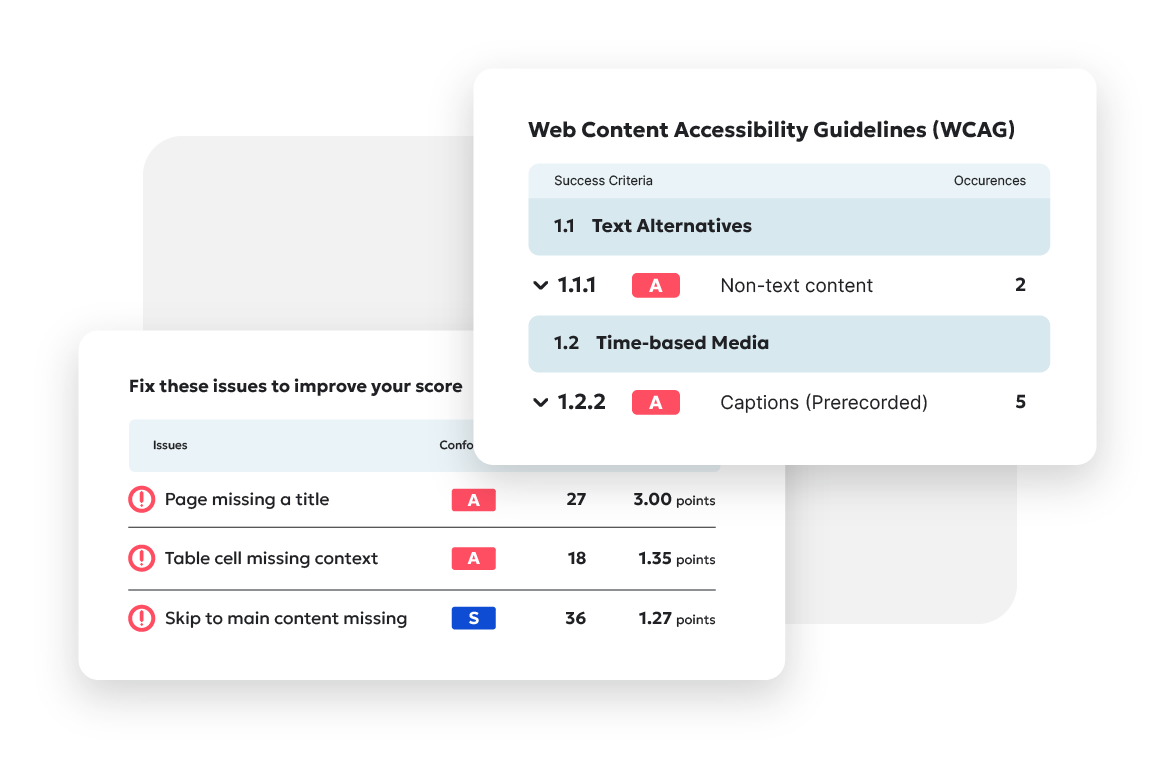There are plenty of compelling reasons to be scrupulous about website accessibility, namely that it’s a legal requirement and it’s the right thing to do to ensure fairness and inclusivity.
Beyond legality and ethical imperatives, there’s another great reason to make sure that every nook and cranny of your site is fully accessible: It’s good for your brand and therefore good for your bottom line.
What digital accessibility is
Digital accessibility is the practice of creating websites and digital experiences designed to be usable by everyone. It is commonly measured by the Web Content Accessibility Guidelines (WCAG), which is a standard maintained by the World Wide Web Consortium (W3C).
The WCAG standard is used to evaluate whether a website’s design is barrier-free and accessible to a wide range of people with disabilities, which can include physical disabilities (including color-blindness), as well as cognitive impairments, temporary disabilities (think broken arm or concussion), as well as to people with situational needs (like being in a noisy room while trying to watch a video).
As Tobias Jensen, digital accessibility specialist at Siteimprove states, “Accessibility is about understanding and adapting to the diverse ways people interact with technology, which allows us to reach an estimated 1.3 billion people worldwide who would otherwise be excluded from engaging.”
Broadly speaking, digital accessibility is rooted in recognition of the diversity of human experience.
The risks of cutting corners with accessibility
In the early days of digital accessibility efforts, brands put accessibility measures in place out of fear of facing lawsuits; now, this fear-based mindset can lead brands to adopt band-aid-style half-measures like website accessibility overlays, which don’t solve the problem given that they’re to blame for hundreds of lawsuits every year.
The good news is there’s overall a far greater awareness of accessibility in our culture, and more brands are equipping their employees with accessibility education.
“Digital accessibility thrives on teamwork,” says Tobias, “By prioritizing collaboration among designers, copywriters, testers, and product managers early in the process, we can more seamlessly enhance the overall success of our digital products.”
Indeed, accessibility is increasingly regarded as part and parcel to larger trends and requirements such as corporate social responsibility (CSR), diversity, equity and inclusion (DEI), and environmental, social, and corporate governance (ESG).
The importance of an inclusivity mindset to your brand
Companies that are on the ball with accessibility tend to embrace inclusive design, a design process that considers the many different people who use your website and the ways in which they use it. Inclusive design isn’t limited to accessibility improvements; it can include elements of branding, messaging, and content strategy.
Digital inclusivity can be broadly divided into five categories:
- Readability, which includes everything from font size to sentence length and structure
- Inclusive language that does not convey biases or discriminate
- Representation via genuine, meaningful content that communicates who you are and what you represent and resonates with diverse audiences
- Usability, so anyone can engage with web content with ease
- Accessibility to keep the digital environment free from barriers

Whereas accessibility is about usability and its impact on the user experience — it‘s a requirement that theoretically has little to do with branding — inclusivity can directly inform brand positioning because it incorporates an understanding of what visitors want from your brand, and it breaks down socially constructed walls so your users can get the most out of your website.
Inclusivity can also mean knowing your audience well enough to take meaningful, relevant action toward causes they support. As their brand of choice, they expect you to be on their side and support those issues. So, when you approach inclusivity as a brand strategy, you’re signaling to them that you get it: You understand your responsibilities, and consumers can trust you. (Patagonia is the master of this.)
How accessibility and inclusivity are related, and why they’re both important
Accessibility and inclusivity are entwined, but they aren’t the same thing, nor do they serve the same purpose. Your website could meet every single WCAG standard of accessibility and still not be inclusive (or even necessarily accessible).
Accessible web design ensures everything on your website is technically available to visitors and organized in smart, sensible ways that align with the digital experience you want to create. This includes things like image alt text, video captions, and properly structured headings.
Inclusive design takes a broader look: It demands understanding user diversity at every level, from the ways they use your website and interact with your brand to the causes they care about most. For example, do you actively try to avoid words or phrases that might offend certain groups of people? Do you make sure to include a variety of people in your illustrations and images?
As our vice president for brand, Hannah McWilliams puts it, “While accessibility in design is more linear — almost binary — in nature, inclusivity is a subliminal mindset that you either incorporate into your brand or not. Are you creating an unbiased brand that can be equally experienced by all?”
The takeaway: Accessibility is a set of rules focused on compliance, while inclusivity is more of a philosophical or values-based consideration: You can’t have an inclusive brand without having an accessible website.

The incentive for brands to move past compliance to inclusivity isn’t just theoretical. Research by Harris Polls commissioned by Google Cloud indicates that 82 percent of shoppers want consumer brands’ values to be aligned with their own; moreover, according to Harris, three-quarters of shoppers reported abandoning a brand because its values weren’t aligned with their own.
Granted, B2B isn’t B2C, but given that every person who interacts with a B2B brand is also a consumer (e.g., many people who choose Dove also buy SaaS), it stands to reason that the numbers would be similar in a B2B context.
In a word, if you don’t nail accessibility and prioritize and express inclusivity, you’re doing so at your peril: You could lose customers.
How to incorporate inclusivity across your brand
First, there are the obvious ways to incorporate inclusivity into your brand, like creating advertisements that reflect and speak to diverse consumers and using gender-inclusive pronouns and language.
Then there are strategies like making inclusivity prominent in your ESG initiatives. Or making sure your brand icons and graphics reflect inclusivity. (Like ours do! Abstract designs are a great way to do this.)
“People often think accessible design cannot be aesthetically pleasing,” says Cameron Gallacher, director of product design at Siteimprove, “It isn’t about sacrificing aesthetics, but about prioritizing usability and value over aesthetics alone.”
Then there are the more “behind the scenes” approaches, like auditing your customer journeys to make sure you’re not losing swathes of customers who don’t feel a sense of belonging at some point in that journey and move on.
“This isn’t the same as being universally liked,” Hannah explains. “Brand is largely subjective, and everyone has their own taste, but inclusive brands ensure that everyone is extended an equal experience and opportunity to connect.”
Ultimately, this means that inclusivity affects spans every aspect of your brand, from “inputs” like SEO to content, web design, and UX. That means it also affects your outcomes, like conversion rates and revenue.
It’s all tied together.
Where Siteimprove fits in
Brands can’t ensure accessible, inclusive web experiences alone. They need help training their teams, systems to flag and resolve issues in digital assets, automation of manual tasks to optimize workflows, and expert guidance and recommendations.
Siteimprove has been at the forefront of the accessibility conversation for over a decade and actively participates in the Accessibility Conformance Testing (ACT) Taskforce, an project funded by the EU Commission.
Our inclusivity solution and accessibility services, like training and testing led by digital accessibility specialists and consultants, empower companies to create exceptional, accessible content to reach their inclusivity goals.
As Skyler Frink from Akamai Technologies says, “Siteimprove Accessibility introduced us to accessibility issues we hadn’t really considered before. It helps with all the common pitfalls like missing alt text, color contrast issues, and skip links.” Skyler and his team trusted us to start their accessibility journey and have already seen a 20 percent improvement in their website accessibility.
Siteimprove Frontier, our hybrid learning and education platform, supports multi-disciplinary digital teams by training and educating about inclusivity and building up accessibility knowledge. Combining accessibility and inclusivity has huge potential for brands to thrive in the digital future, but it means acknowledging and reflecting the real world your brand exists in. It’s the same one they’re living in — and the same one we need to make available and approachable for all.

Ready to create more accessible and inclusive web content?
Siteimprove Accessibility can help you create an inclusive digital presence for all.
Request a demo